Chario,
Academy, Sonnet
Copyright
2010 © Troels Gravesen
Discontinued as kit from Jantzen Audio. Source
components locally.
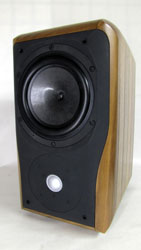
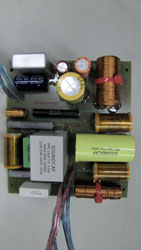
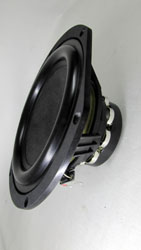
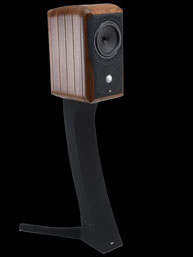
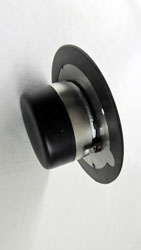
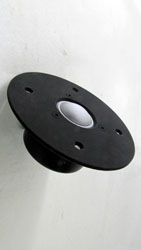
Download Sonnet Manual
Link to
Chario website
Crossover Up-grade Kit
Do not expect
a Stereophile type of review of these charming
Chario Academy Sonnet loudspeakers. I cannot
write page after page of how a loudspeaker
sounds. It takes special skills to extend
listening impressions page after page. Sometimes
I enjoy reading reviews and sometimes I'm utterly
bored by a writer repeating himself time after
time on recordings I don't even know. What I
usually try to extract from speaker reviews is
any tiny reservation, any subtle selection of
words or phrases that may imply that the reviewer
is not entirely satisfied with the product.
Obviously a review has to be positive, otherwise
no adds from the manufacturer next month. I have
to give in that Stereophile had two negative
reviews early this year - and my God, the
manufacturers got mad! How Vince Bruzzese of
Totem Acoustic could make a total ass of himself
in his response was truly embarrassing for Totem.
Read Stereophile Jan-10.
Anyway, I had a
mail from nnnn, asking me to make a new crossover
for his newly acquired Chario Sonnets, and having
only recently heard these speakers at the
Copenhagen dealer - and being pleased with what I
heard - I was somewhat surprised and responded
that these Chario guys were probably not any guys
- and I felt pretty sure they'd given the
crossover some deep thought before launch.
Hmm..... Two months went by and nnnn had found
himself very pleased with the speakers, but
offered me to borrow the speakers and check out
the crossover for possible up-grades. Not a new
crossover, but better components, because what we
find in the Sonnet is a bunch of tiny cored coils
and loads of electrolytic caps! The quality of
crossover components is in severe contrast to the
meticulously crafted cabinet, binding post and
everything else you can observe from this
speaker. Good crossover components are expensive
and seriously add to production cost and even in
excessively expensive speakers we may find
so-and-so components. It doesn't help being
uncompromised if it puts you out of business. As
always, we're into diminishing return of our
investment when going to the extreme and for most
people it may not count at all. Most speakers are
bought based on looks, rather on sound quality.
The Sonnet cabinet is
a masterpiece of CNC manufacture. Solid walnut
sides and top. Front and rear panels from
sculptured MDF a diy'er can only dream about ever
making. Binding posts specially made for Chario
(expensive) and both drivers are bolted to the
cabinet by state of the art T-nuts. Even the
screws holding the drivers are specially made to
fit the chassis and finished by what looks like
the same nextel coating applied to rear and front
panel. Total yummy to the eye and for the hands
holding them.
Both drivers are custom made and ooze quality.
Bass driver features machined magnet parts and a
proprietary Rohacell cone, molded in one piece
with none of the problems often seen from poorly
made dust caps. Chario has chosen not to do
anything about the all too common 1 kHz rubber
surround resonance problem, but it's not severe
and finding the "right" rubber surround
may cause other problems.
Chario is a true believer in large domes and I
like it. Read TQWT article.
Here we find a 32 mm dome with silver coating and
before I had the opportunity to dismantle the
Sonnet, I had a suspicion this dome was a variant
of the venerable Audax TW034, but this is not the
case. Once more a proprietary driver*.
Cloning this speaker is not possible, thus I have
no reservation in revealing the crossover in
detail. And by the way; I've read (or rather seen
as I don't read Italian) several Italian speaker
reviews with thorough description of crossovers
incl. schematics. Apparently comme il faut beyond
the Alps.
*: I actually think the Sonnet
tweeter is a derivative of Ciare MT320 with
another face plate and rear chamber. The larger
domes in some of Chario's portfolio for sure look
like Ciare PT383 so I guess Chario is a frequent
customer at Ciare company.
The crossover is
not the least interesting part of this speaker.
Basically a 2nd order filter at 1180 Hz. End of
story? Not quite. You need to read the manual for
this speaker to get the story behind the chosen
point of crossover because it's a long one. Here
some quotes:
"As a corollary to
this rigorous scientific status, we at Chario
Loudspeakers assert once again that it is always
possible to work miracles in doing our job, but
it is never possible working miraculous designs
beyond physical laws boundaries. Sonnet proudly
stands at the borderline of audio knowledge
waiting for audiophiles to listen to their
authoritative voice, because …we think
differently!"
Hmm...Who
wrote this pretentious academic monbojumbo? I
find a contradiction between what's written in
these manuals and the honest product performance
claims. Because for once we get performance data
and measurements that appear to truly reveal what
their speakers do. Sonnet: Claimed 90 dB
sensitivity is exactly what I measure. Impedance
plots, frequency plots, etc., all in accordance
with my findings. Excellent!!
BTW: If we go to the Copenhagen dealer on Chario
speakers we find 93 dB sensitivity and F3 = 50
Hz. Chario website (and manual) states 90 dB/2.8V
and F3 = 55 Hz. I guess this is what we can
expect from an Audio Note dealer...... http://www.audioconsult.dk/.
"Frequencies below
about 700 Hz are processed by determining the
arrival time to each earpinnae and this is
referred to as IT ). Frequencies above about
1,400 Hz are processed by determining the energy
flow delivered to each era-pinnae and this is
referred to as IAD (inter-aural amplitude
difference). We soon recognize Duplex Theory not
to be exhaustive because it fails to correctly
explain the localization process within the
missing 700-1,400 Hz range. At these frequencies
head & torso are enough obstructive to modify
the incoming wavefront (diffraction) so that the
crossover from ITD to IAD is not linear and
localization cues are not flawless."
What appears to
be the long and the short of it, is this: The
ear detects sound in two ways as described above.
I've checked Wikipedia and this seems sound
knowledge. http://en.wikipedia.org/wiki/Interaural_time_difference. So,
between ~700 and ~1400 Hz our brain has trouble
finding out what the heck is going on, so by
placing the point of crossover between these two
frequences, we fool the ear/brain and we can't
find out whether the sound comes from one driver
or the other. Result: Perfect driver integration!
Does this make sense to you? If not, please post
me your interpretation. By the way: In the
laboratory where I work, we have three incubators
side by side. Whenever an alarm (~1 kHz sine
wave) goes on, it's impossible to hear from which
incubator the damn sound comes, so maybe we have
trouble localising sounds from this frequency
range). Just a thought.
What is a bit disturbing is that the Sonnet
drivers integrate very well. And not only well,
but excellent. Came to think of my SP44 speaker
with the Accuton dome dome crossed at 900 Hz...
Overall phase integration between the Sonnet
drivers is not perfect and with the speaker tilt,
the bass driver is serious behind the tweeter
making this an anything but time or phase
coherent speaker. Check step response below.
Chario Sonnet
also features proprietary WMTTM
technology. So, what is WMT? Basically it means woofer-mid-tweeter
with the woofer on top. Like Dynaudio used to do
- and sometimes still do, so this can't be all
that proprietary. You get the lower mid - in
particular - off the floor and reduce floor
bounce. Not a bad idea at all.
The choice of
crossover components is disturbing too.
A strange blend of film and electrolytic caps.
For the bass driver's shunt cap two different
film caps to make 50 uF. Why not a single e.g. 47
uF Solen cap. For the bass LCR circuit (to
flatten upper bass impedance peak) four different
electrolytics bypassed by a 1.2 uF film cap to
make 322.2 uF. Why not a single 320 uF
electrolytic? No problem in finding that. For the
tweeter a 2.2 uF film cap and next 21.3 uF from
two different film caps. Why not a single 22 uF
polyprop? No problem in finding that either. I
don't get it. In particular the bunch of strange
electrolytics for the bass LCR. The use of a PC
board is another no-no for bewildered
audiophiles. The possibility of targeting a
particular sound from the blend of these
particular caps simply doesn't make sense. I'm
sure this is not the case. The simple reason may
be to minimise the general wide spread of
electrolytic capacitor values. Usually
electrolytic caps are +/- 5-10%, but for this LCR
circuit precision is not overly critical, so this
really doesn't make sense either.
I guess the Chario crew doesn't give a damn about
my preference for high-cost super caps and the
like. Audiophile woodoo and snake oil! These
Sonnets' owner will replace all caps with super
caps and polyprops and time will tell whether
this is worthwhile.
With regard to the coils used, my only objection
is the bass driver's 1.75 mH series coil made
from very thin wire wound around a long ferrit
core. This will be replaced by a huge air-cored
coil from 1.6 mm wire.
All resistors appear to be wire-wound low
inductance types. No tweaking here. The cabinets'
solid wood panels are rather resonant and will de
damped by 4 mm bitumen pads. Finally the internal
wires will be replaced by gold-plated silver
wires as nnnn has a preference for this. That's
all.
There are many
ways to make good speakers and Chario
Sonnet is certainly one of the better. Bass
appear deeper than cabinet size and measurements
suggest. It may not be the most punchy and
precise, but it has good volume and overall
something most people could live with. Next you
have a "Half-exponential Hourglass
Type" vent according to manual! How about
that?
Midrange is nothing short of excellent with great
level of transparency and lack of colouration. As
mentioned earlier, mid-tweeter integration is
perfect and the large dome has no trouble
providing airiness to the presentation, most
likely thanks to a serious elevated response from
6 kHz to beyond my hearing. The dip between 2-5
kHz probably adds to the fact that this speaker
is quite tolerant on program material.
These Chario guys have their own ideas and thanks
for that! It's been a pleasure investigating
their product and hear what they have made of a
classic six-plus-five-quarter-inch stand-mount
speaker. I'm looking forward to hearing the two
speakers with an up-graded crossover - and
playing equally loud! Read below.
Further
information on interaural time difference can be
found here: http://en.wikipedia.org/wiki/Interaural_time_difference
More info by google "duplex
theory"
By the way:
After having finished the page here, I found a
review in Stereophile of the Chario Academy
Sovran speaker. This 3-way has the same upper
drivers - and most likely crossover similar to
this Sonnet speaker. I was pleased to see my
measurements confirmed by John Atkinson, i.e. the
lack of response the the 2.5-5 kHz region, the
seriously elevated response above 7-8 kHz and not
least reading Michael Fremer's sonic impressions,
which were well in accordance with my own:
The Sovran impressed me most
with its rock-solid rhythmic coherence and its
clean, nimble attack, followed by its smooth
tonal balance. Add to that its solid imaging and
impressive soundstaging—depending on the
speaker positions, you have a choice of a deep,
narrow soundstage or one that's a lot wider and a
bit shallower, but with consistent reproduction
of timbres either way. Add to that the
meticulously finished cabinets of solid hardwood,
exceptional resolution of high-frequency detail
with only a slight tilt toward brightness, and
you have a speaker that, while not inexpensive,
offers exceptional performance with fit'n'finish
to match. But equally impressive was what I
didn't hear from the Sovran: bloat, false warmth,
etch, grain, or—especially—congestion.
- even without the subwoofer.
|
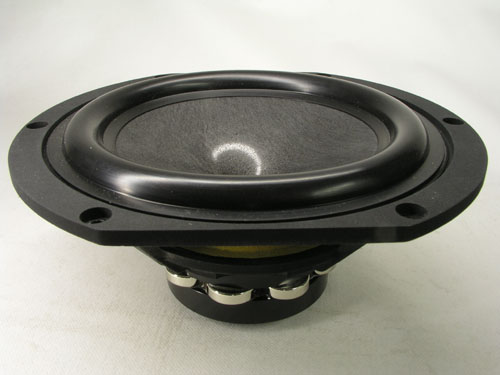 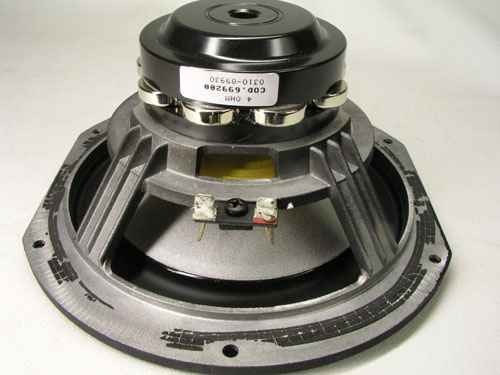
Sonnet bass driver. Rubber surround,
kapton voice coil former, neodym magnets and machined
magnet parts. Nice driver!
Sonnet crossover
LspCAD simulation
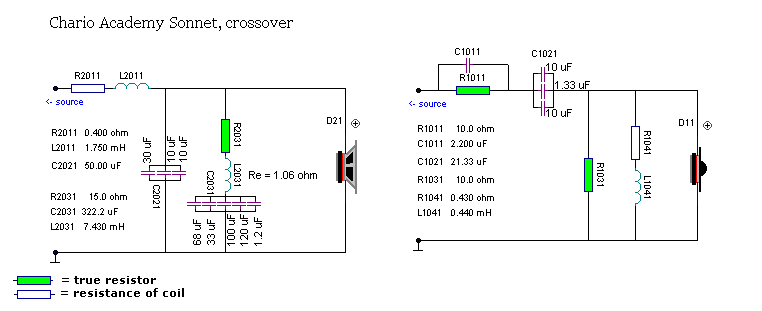
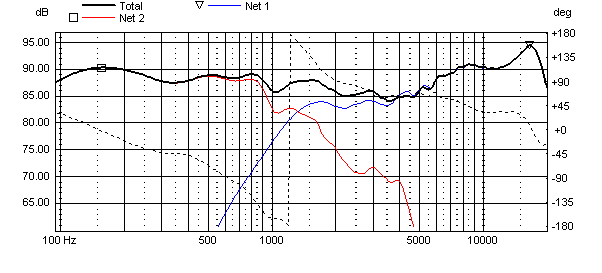
Simulated
crossover with dZ = 45 mm. Very close to actual
measurement.
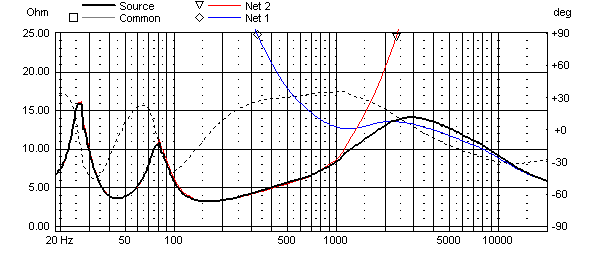
Predicted
system impedance.
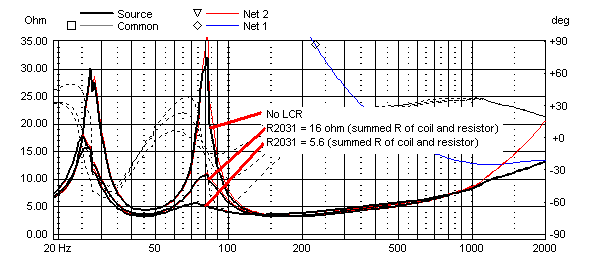
Impedance
from various values of R2031.
Some bass-tuning may be possible depending on placement
in room.
Sonnet, measurements
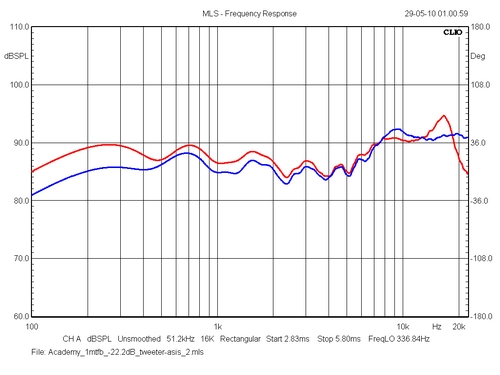 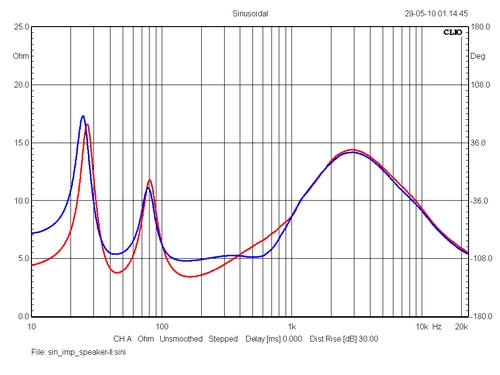
Left: Actual SPL/2.8V @ 1
meter for left and right speaker, tweeter axis
(speaker mounted on Chario stand). Hmm.... gotta
be something wrong here...
Right: Measured system impedance of both
speakers. Quite some difference!
Measuring Re of both bass drivers reveal 3.21 and
6.16 ohms. Both have labels stating 4 ohms, but
one is certainly an 8 ohms driver. Now,
considering the overall impeccable fit'n finish
and a ~1700 EUR/ea price tag, this is a major
flaw by Chario. No quality control? The Sonnet
speaker is rated 4 ohms and I'm sure the correct
bass driver has 4 ohms impedance. Bad, bad....
NB: The owner immediately
contacted the dealer and two new woofers are on
the road from Italy. Excellent service! Chario
suggested the "8 ohm driver" has a
damaged litze wire - or something - as they don't
produce this driver in 8 ohms version. This makes
sense as TS measurement suggests an unusual high
Qt of 0.65. A straight 8 ohms voice coil would
not alter the Qt that much.
|
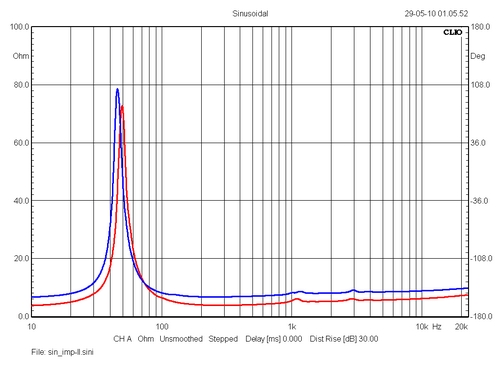 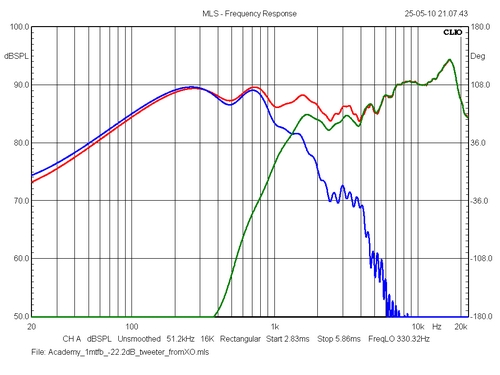
Left:
Free air impedance of both bass drivers.
Right: Response of individual drivers and summed response
(red) driven from crossover (4 ohms bass driver).
Measurements below all on 4 ohms
speaker.
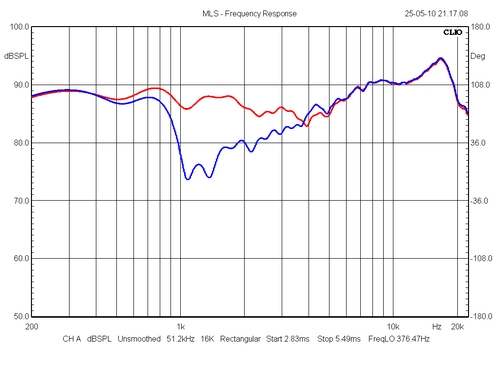
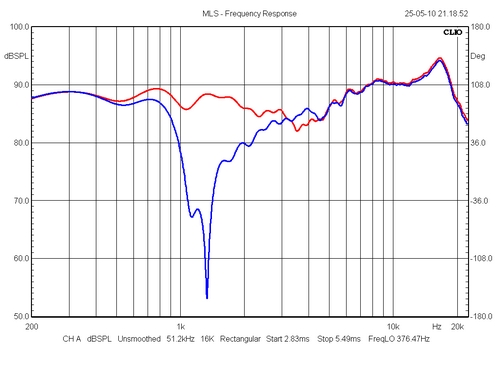
Left:
Tweeter with correct (red) and inverted (blue) polarity.
Measured at tweeter height. Speaker on original stands.
Right: Response with inverted tweeter polarity at 5 deg.
below tweeter axis (1 meter).
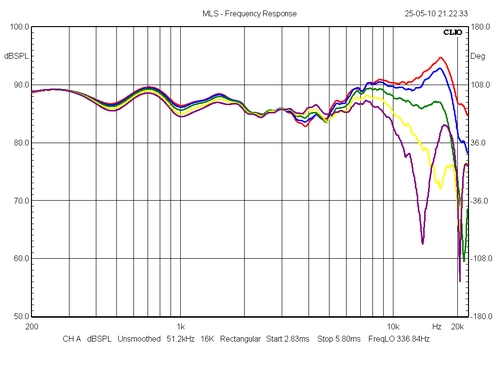
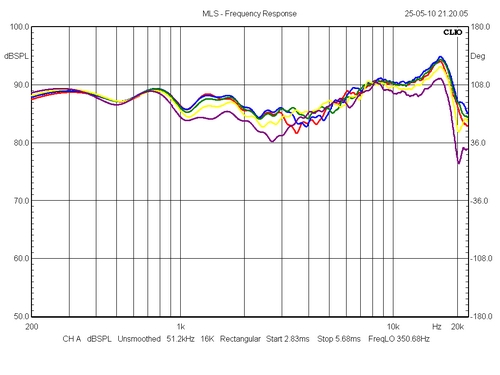
Left:
Horizontal dispersion at 0, 10, 20, 30 and 40 deg. Chario
recommends placement parallel to front wall, thus a
fairly flat response at listening position.
Right: Vertical dispersion (1 meter) from lower edge of
cab to upper edge of cab).
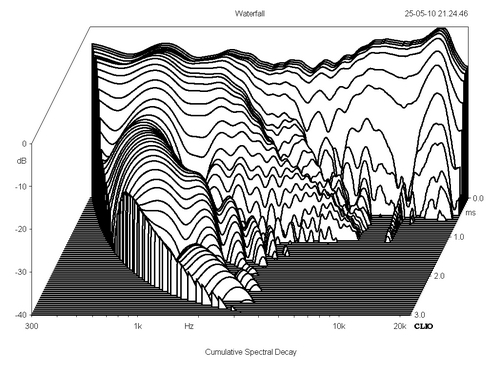 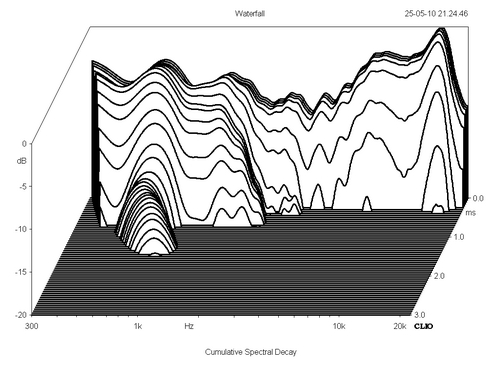
Left:
CSD, 40 dB scaling. Right: CSD, 20 dB scaling.
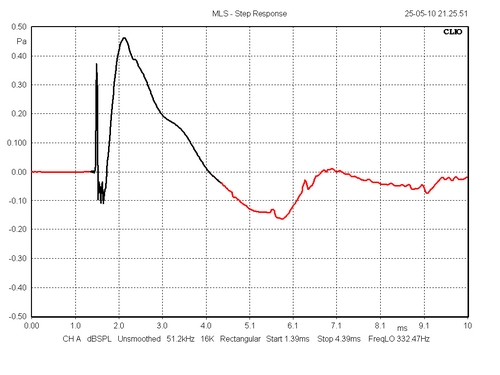 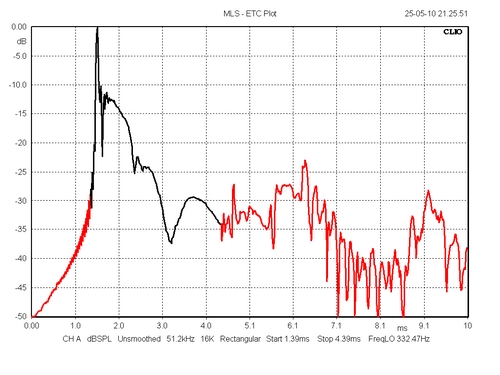
Left:
Step response. Right: ETC plot.
Drivers,
no crossover:
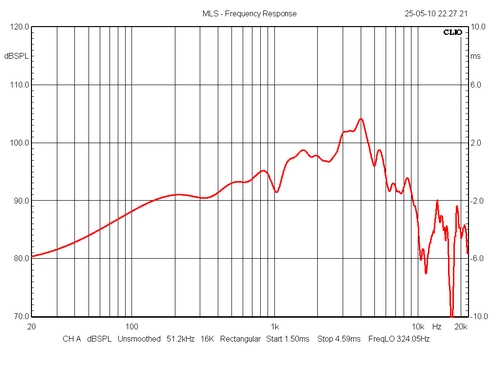 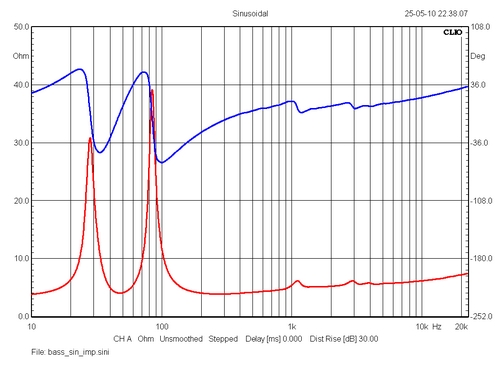
Left:
Response of bass driver in cabinet without crossover. As
can be seen the bass driver's rubber surround has
problems at 1 kHz as is the case for a lot of drivers.
Right: Impedance of bass driver in cabinet without
crossover. Minor resonances at 1, 3 and 4 kHz.
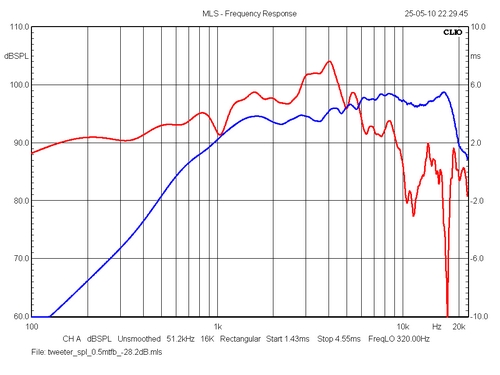 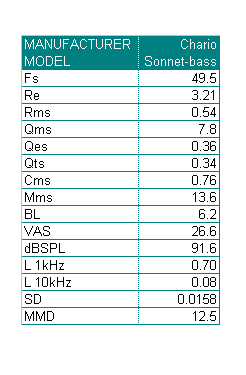
Left:
Blue = tweeter response without crossover. Very sensitive
driver!
Right: Measured TS data for one driver. Cabinet volume
~17.5 liter. Port tuning (Fb) = 46 Hz. F3 = 60 Hz. This
is quite an efficient driver thanks to the 4 ohms voice
coil.
Sonnet
Tweeter
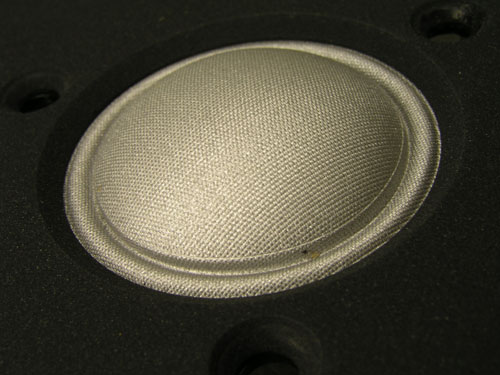 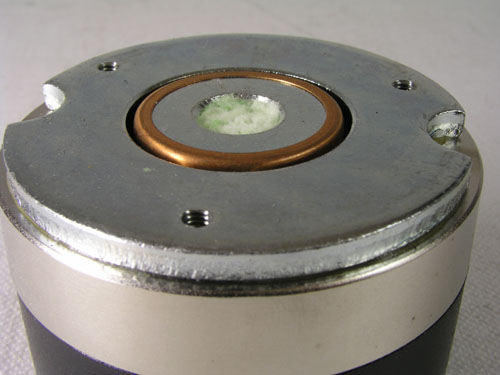
Tweeter features fabric
dome and suspension, kapton voice coil former,
vented pole piece and not least: Symmetric drive!
The copper sleeve reducing eddy currents goes all
the way to the bottom of the center pole piece
and this is the way it should be made. A copper
ring here and there doesn't quite make it.
The dome itself is special having surround and
dome made from the same fabric, yet glued
together right above voice coil. The surround
almost rises vertical before being glued to the
dome. This may improve energy transfer from the
voice coil to the dome and enhance high frequency
response.
The thin walled plastic cup making the rear
chamber is highly resonant and may benefit from a
MDF disc glued to the cup.
All in all it seems Chario knows where to spend
the money.
The tweeter here is by large
identical to the Ciare MT320 tweeter. The Sonnet
tweeter does not have the rounded edges of the
center pole piece like the MT320 and it comes
with a larger rear housing, something that based
on measurements is hardle needed. Finally the
Sonnet dome has a silver coating where the MT320
comes in black, obviously nothing that will
impact the sound. Read here:
http://www.troelsgravesen.dk/large_domes.htm
|
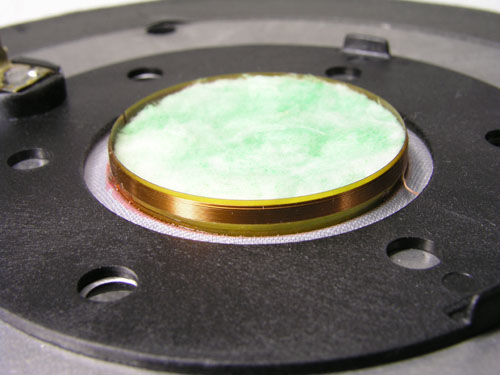 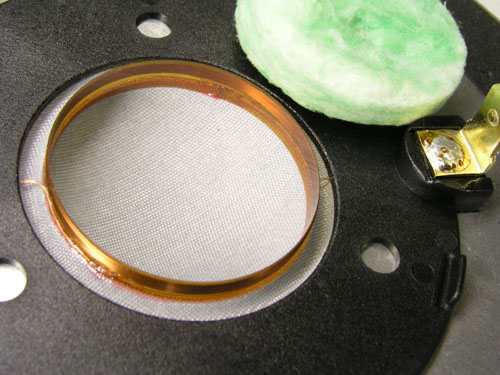
Unconventional
damping of tweeter pole piece. A large foam plug is stuck
within voice coil former. The entire dome is resting on
this pillow.
Crossover
Up-grade Kit
Discontinued as kit from Jantzen Audio. Source components
locally.
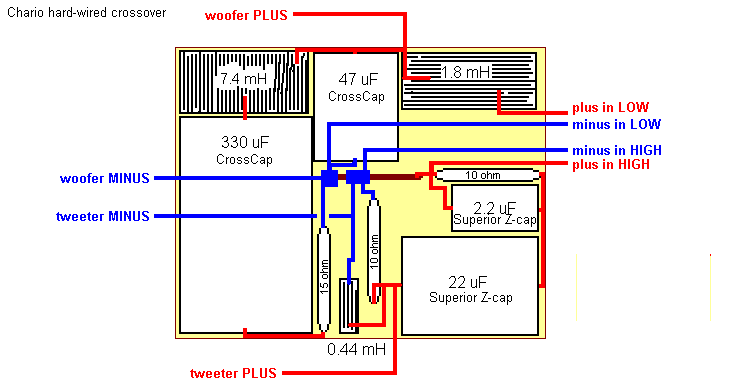
Suggested hard-wired crossover. The board is 9 x 145 x
180 mm Baltic birch.
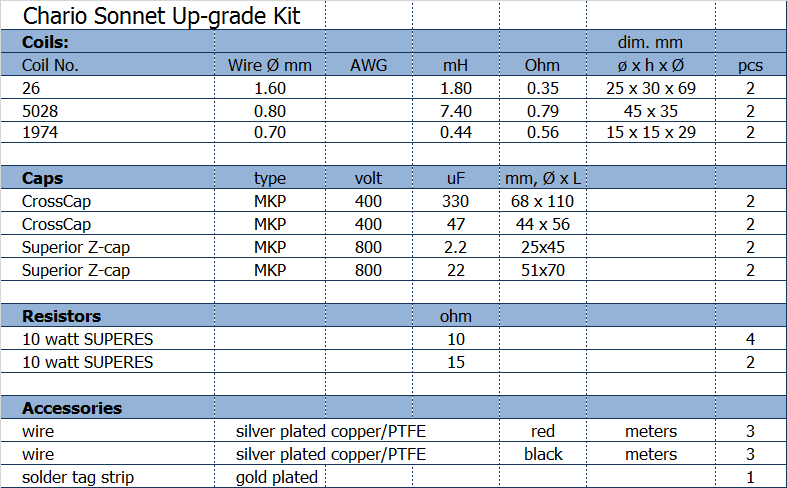
All technical questions to
troels.gravesen@hotmail.com
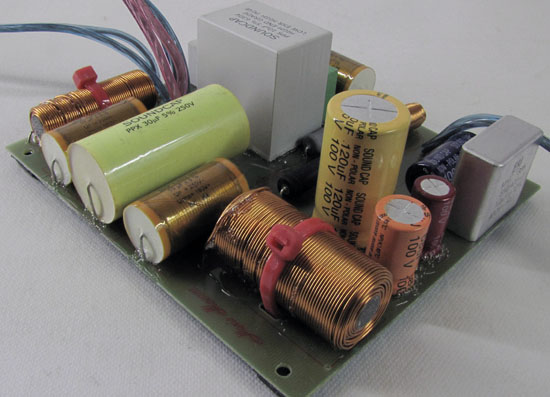
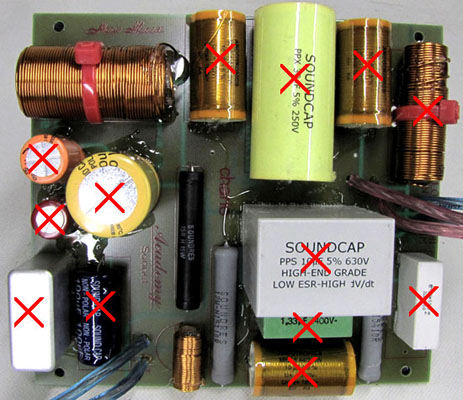
The original crossover board.
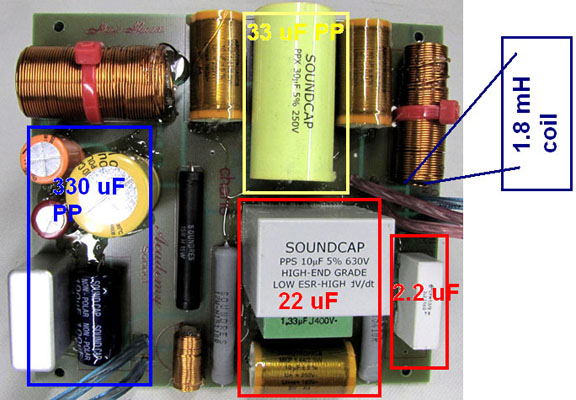
Identifying the capacitors and coils. This is
the weirdest collection of caps I've ever seen:
e.g. 5 different caps
to make up 330 uF! What's going on?
Below
the up-graded, hard-wired crossover.
Click images to view large.
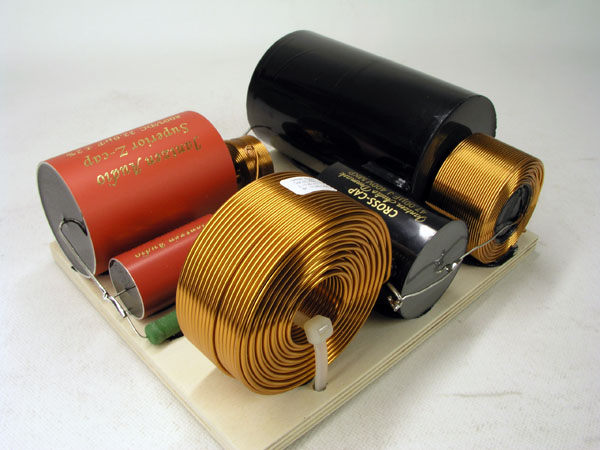
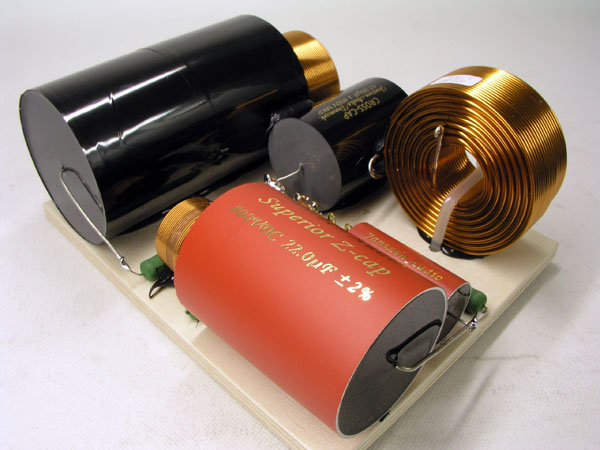
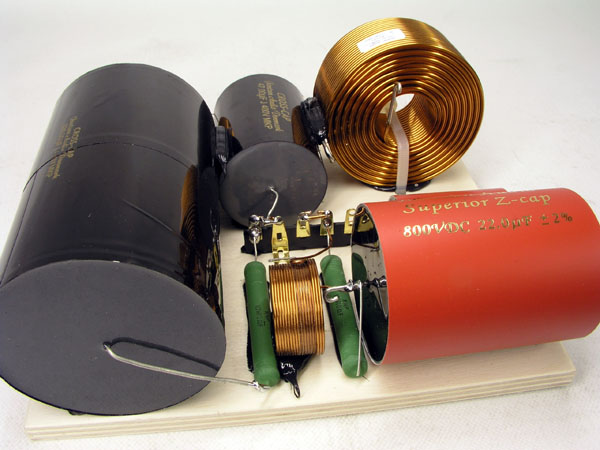
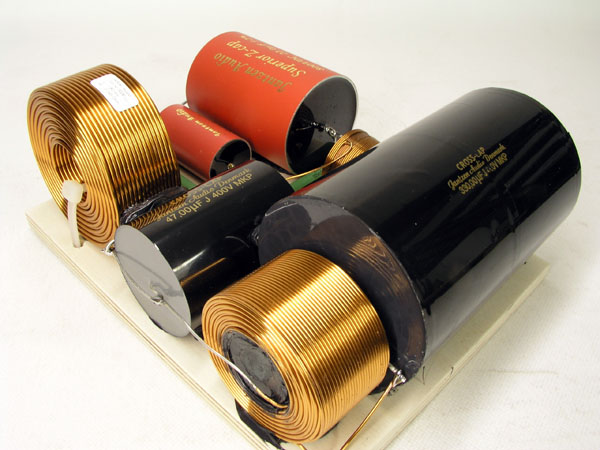
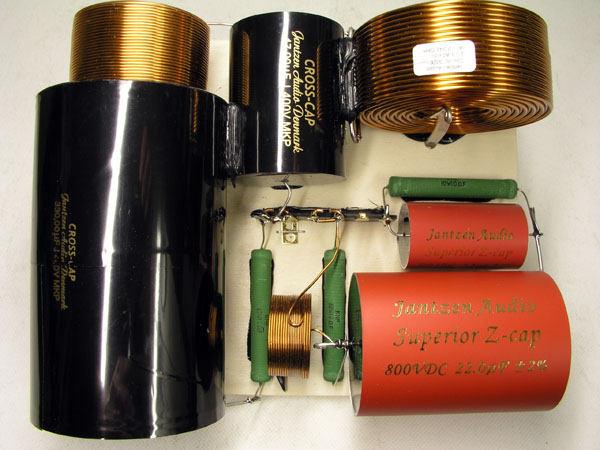
Having installed the new
crossover we could hardly wait hearing the result
- and we were not disappointed. I'm not much of a
believer in crossover burn-in and right out of
the workshop, hooked up with the Jungson class A
amp, High Life from the Pawnshop was as
transparent as I'm used to from the DTQWT
although not with the same low-end extension and
dynamics - for obvious reasons.
The overall sound is more tight and transparent
compared to the standard crossover, revealing
more layers in the acoustic image and I couldn't
help noticing the even power response making your
placement in front of the speakers less critical
than many other speakers. No hot spot here!
Treble is more fresh and clean and without any
aggressiveness from even that most near-miked
saxophones or vocals. These large domes have made
me think - once more - of future projects.
| Response
to Chario article. Comments may be posted if
found relevant to the article and may be edited.
Q:
Regarding the X-over for the Chario Sonnet where
you question the use of multiple, paralleled
capacitors I have a simple suggestion. If we view
the capacitor as a dynamic device with a complex
impedance then I would argue that the circuits
reactance is; Reactance(Cap A) + Reactance (Cap
B) and NOT Reactance (Cap A + Cap B), especially
for complex wave-forms. My assumption is that the
multiple paralleled capacitors
"sound" different. Maybe it is
worth a hearing test - though I am quite clueless
as how to choose the appropriate waveforms.
Richard.
A: Been thinking the same thing. It has to seen
(heard) whether this really impacts performance.
The filter is active below 100 Hz and my best
guess is that the quality of the cap(s) is
irrelevant, but I wouldn't be surprised if Chario
think it is. Troels.
Q:
Do you know, where the midwoofer are available to
buy, for some Diy Projects? Thanks in front.
Alex.
A: Hi, all drivers are proprietary. Only made for
Chario. Troels
|
|



































